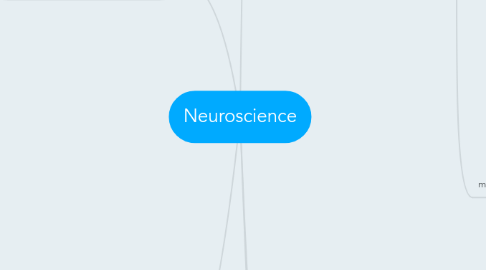
1. Cognitive neuroscience
1.1. consciousness
1.1.1. neural correlates of consciousness
1.1.1.1. neuronal correlates of alternating perception in binocular rivalry
1.1.1.2. visual awareness and human brain activity
1.1.1.3. challenges in the study of consciousness
1.2. Language
1.2.1. About language
1.2.2. The specialized area of the language
1.2.2.1. Broca's area
1.2.2.2. Wemicke's area
2. Molecular Neuroscience
2.1. Neurons and Glia
2.2. The Neuronal Membrance
2.3. The action Potential
2.4. Synaptic Transmission
2.5. Neurotransmitter systems
2.6. The structure of the nervous system
3. Behavior Neuroscience
3.1. Chemical control of the brain and behavior
3.1.1. hypothanlamus
3.1.1.1. autonomic nervous system
3.1.1.2. diffuse modulatory systems of the brain
3.2. Motivation
3.2.1. long-term regulation of feeding behavior
3.2.2. short-term regulation of feeding behavior
3.3. sex
3.3.1. hormonal control
3.3.2. neural basis
3.4. emotion
3.4.1. early thoeries
3.4.1.1. The James-Lange Theory
3.4.1.2. The cannon-Bard Theory
3.4.1.3. Unconscious emotion
3.4.2. limbic system
3.4.2.1. Broca's limbic Lobe
3.4.2.2. The Papez circuit
3.4.3. Emotion theories and neural representations
3.4.3.1. Basic theories
3.4.3.2. Dimensional emotion theories
3.4.3.2.1. Psychological constructionist theories of emotion
3.4.4. fear and the amygdala
3.4.5. anger
3.5. Brain rhythms and sleep
3.5.1. electroencephalogram
3.5.2. sleep
3.5.3. circadian rhythms
3.6. resting
3.6.1. the brain's default mode network
3.7. attention
3.7.1. behavioral consequences of attention
3.7.2. physiologigcal effects of attention
3.7.3. brain circuits for the control of attention
3.8. mental illness
3.8.1. approach to mental illness
3.8.1.1. psychosocial approaches
3.8.1.2. biological approaches
3.8.2. anxiety disorders
3.8.2.1. a description of anxiety disorders
3.8.2.1.1. panic disorder
3.8.2.1.2. agoraphobia
3.8.2.2. other disorders characterized by increased anxiety
3.8.2.2.1. post-traumatic stress disorder
3.8.2.2.2. obsessive-compulsive disorder
3.8.2.3. biological bases of anxiety disorders
3.8.2.3.1. stress response
3.8.2.3.2. regulation of the HPA Axis by the Amygdala and hippocampus
3.8.2.4. treatments for anxiety-disorders
3.8.2.4.1. psychotherapy
3.8.2.4.2. anxiolytic medications
3.8.3. Affective disorders
3.8.3.1. a description of affective disorders
3.8.3.1.1. depression
3.8.3.1.2. bipolar disorder
3.8.3.2. biological bases
3.8.3.2.1. The monoamine hypothesis
3.8.3.2.2. The diathesis-stress hypothesis
3.8.3.2.3. Anterior cingulate cortex dysfunction
3.8.3.3. treatments for affective disorders
3.8.3.3.1. electroconvulsive therapy
3.8.3.3.2. psychotherapy
3.8.3.3.3. antidepressants
3.8.3.3.4. lithium
3.8.3.3.5. deep brain stimulation
3.8.4. Schizophrenia
3.8.4.1. a description of Schizophrenia
3.8.4.2. Biological bases of Schizophrenia
3.8.4.3. Treatments for Schizophrenia
4. Systems Neuroscience
4.1. Motor system
4.1.1. Spinal tracts
4.1.2. Cerebral cortex
4.1.3. Basal Ganglia
4.1.4. Primary motor cortex
4.1.5. Cerebellum
4.2. Visual System
4.3. Chemical Sense
4.3.1. Taste
4.3.2. Smell
4.4. Auditory and Vestibular systems
5. Cellular Neuroscience
5.1. The genesis of neurons
5.1.1. cell proliferation
5.1.2. cell migration
5.1.3. cell differentiation
5.2. The genesis of connections
5.2.1. a growth of axon
5.2.2. axon guidance
5.2.3. synapse formation
5.3. the elimination of cells and synapse
5.3.1. cell death
5.3.2. changes in synaptic capacity
5.4. activity-dependent synaptic rearrangement
5.4.1. synaptic segregation
5.4.1.1. segregation of retinal inputs to the LGN
5.4.1.2. segregation of LGN inputs in the Striate Cortex
5.4.2. synaptic convergence
5.4.3. synaptic competition
5.4.4. modulatory influences
5.5. elementary mechanisms of cortical synaptic plasticity
5.5.1. excitatory synaptic transmission in the immature visual system
5.5.2. long-term synaptic potentiation
5.5.3. long-term synaptic depression(LTD)

